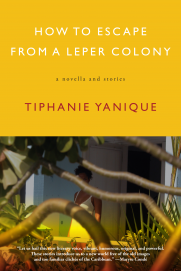How to Escape from a Leper Colony, a Review by Carissa K. Cullum
 The Caribbean, home to a myriad of dynamic cultures from across the globe, is the backdrop for Tiphanie Yanique’s collection of short stories. Each tale includes memorable characters that represent the many diverse ethnicities found throughout the many islands; and incorporates themes of love, coming of age, the after effects of colonization, and the many ways the different cultures coalesce and clash. Altogether, the stories within How to Escape from a Leper Colony embrace and portray everything that makes the Caribbean unique.
The Caribbean, home to a myriad of dynamic cultures from across the globe, is the backdrop for Tiphanie Yanique’s collection of short stories. Each tale includes memorable characters that represent the many diverse ethnicities found throughout the many islands; and incorporates themes of love, coming of age, the after effects of colonization, and the many ways the different cultures coalesce and clash. Altogether, the stories within How to Escape from a Leper Colony embrace and portray everything that makes the Caribbean unique.
How to Escape from a Leper Colony
Deepa arrives on the Trinidadian island of Chacachacare for two reasons: to bury her father and to join the leper colony. Coming from a mixture of African and Indian heritage, Deepa tries to find herself among the Christian and Hindu values that had been instilled in her from a young age. Her adventures with a boy named Lazaro result in disfigurement, the death of a nun, and an improvised escape from the colony.
The Bridge Stories
A local jewelry maker is paid by Yankees to construct an immaculate bridge that spans from the South American country of Guyana to Miami, Florida, connecting all of the Caribbean islands along the way. Through a wonderful interweaving of local folklore, we learn about the odd collection of characters that are lost as the bridge collapses upon its completion.
Street Man
Anton Colter makes his spare change by selling drugs in St. Croix, Virgin Islands. After falling in love with Yolanda, an Island girl about ten years his junior, Anton becomes concerned that his girlfriend’s education in the States will keep her from ever loving a local thug. He finds these doubts to be true after watching Yolanda sneak off to a bar on the other side of the Island for her spoken word performance.
The Saving Work
In Yanique’s hometown of St. Thomas, Virgin Islands, two women arrive at the church where their children are to be married, only to find it in flames. Each silently blames the other for the ruination of her church and her child. As the women alternate between bewilderment and hysterics, we learn about the love triangle that is the reason behind their children’s impromptu marriage and the fire.
Canoe Sickness
A disease that the narrator believes to have originated amongst the indigenous people of South America, “Canoe Sickness” describes the trance-like state that the Caribs would experience when patiently hunting sharks. The narrator comes to experience this debilitating sickness anytime he sees his father—whether he’s spying from his parents’ closet, groping his girlfriend in the movie theatre, or playing soccer—and it follows him well into his adult life.
Where Tourists Don’t Go
Mason lives in Texas with his girlfriend, Robin; she was raised in Chicago, he was raised in Jamaica. When the annual I-Festival returns to Houston this year with a “Come back to Jamaica!” theme, Robin insists that they go. During the couple’s visit, cultural differences begin to show, leading Mason to sneak off to a nearby church and return with a special souvenir.
The International Shop of Coffins
When two high school girls enter the coffin shop on a whim, we learn more about the individual lives of a priest from Gambia, the store owner, and one of the young ladies. Through their personal histories, we see the emotional effects of having lost loved ones and the way this loss affected their coming of age stories. Following an unfortunate car accident, the reader is brought back to the shop—this time, to witness a purchase.
Kill the Rabbits
Murdering the white people who inhabit the Virgin Islands—that’s the horrifying message behind the theme song for this year’s Carnival. The reader follows the experiences of three people caught in a love triangle during the present festival, and the Carnival celebration twelve years ago that featured the same song. Though nothing much comes from their relationships, we are able to see the overwhelming power that love can have over people.
Perhaps it is this love—the love for the Caribbean and its culture—that has lead Yanique to create this inspiring collection that consumes the reader completely, leading them to love each character the way Yanique loves her fellow Caribbean people.
For more information on How to Escape from a Leper Colony visit: www.graywolfpress.org
How to Escape from a Leper Colony: A Novella and Stories. Tiphanie Yanique. Minneapolis: Graywolf Press, 2010. Print.




I finished this book last week and it was everything! I was definitely consumed. I’ll read her novel next month. If it tops this short story collection, I just won’t even know what to do with myself!